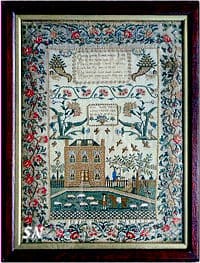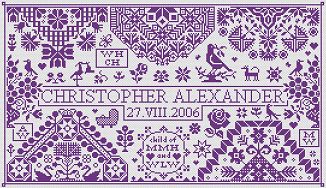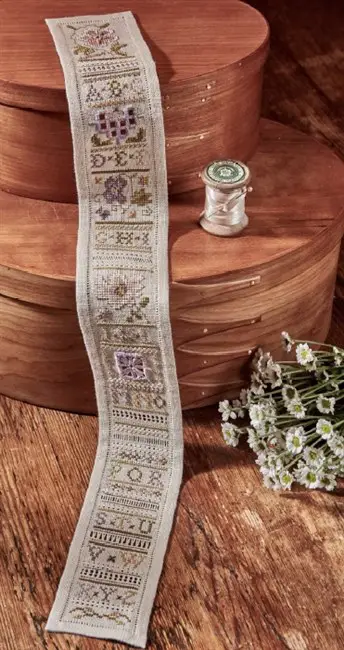What Is A Cross Stitch Sampler And How Are They Used?
If you have ever enjoyed a box of Whitman’s chocolates, you may recall the box design is that of a stitchery sampler, which is meant to exemplify the Whitman’s Sampler box. Inside there is a little something of every variety of chocolate they produce. This is the idea behind the cross-stitch sampler.
What is a cross stitch sampler? Well, in basic terms, a sampler is a “sample” of someone’s embroidery work. In the past, it was shown as a way of displaying just how good of a needleworker you were! Frequently these samplers featured the alphabet or numbers as these “samples” were easily compared against others to determine which stitcher was better.
Samplers Have a Place Throughout Our History
Originally used as an example of the different stitches, their effects and designs that could be stitched, samplers contain all manner of subjects and styles of designs. The samplers that have been saved through the centuries reveal the stitches and patterns from different cultures that widely practiced needlework. The earliest examples date back to the ancient Egyptians.
We often see scenes of the ladies in the Tudor Queen’s court sitting in a sewing circle. Early German samplers contained ecclesiastical motifs probably used as inspiration for church linen. Italian linen samplers were more elaborate with border patterns used to decorate personal and household linens.

A Method of Copying Using the Sampler as a Guide
The significance of a sampler has everything to do with the ages before there was such a thing as a printing press or copy machines. Experienced hands working the examples produced a sample of the many different stitches, motifs and designs. They were the guides for countless ways to manipulate the embroidery floss to create everything from alphabetic letters to medallions to intricate borders to insignia and so much more.
List Of Over 150 Cross Stitch Pattern Stores Online
As needle workers noticed an interesting example of a stitching pattern, they would work to recreate a small example to preserve as their own sampler. This was the method of collecting the different stitches and patterns throughout one’s lifetime. In some instances, samplers contain a recorded date.
They were used to commemorate the birth of a child typically incorporated into the closely fitted samples. Linen was costly. It is one of the reasons the sampler contained the respective elements closely situated or in repeating bands to make the most of the available fabric.
They are the earliest form of pattern books that we use today, only they were not books. They were these singular pieces of linen that comprised a variety of the different stitches, designs, letters and figures. They gave the physical examples of needle craft for inspiration and a means of transferring the skills among the ladies from one generation to another.
Forms of Samplers Evolved as Necessary
Early “spot samplers” focused on more random elements whereas “band samplers” had an obviously ordered arrangement of patterns and figures. They contained elements such as birds, animals, flowers, fishes and the like worked in the form of borders. As a teaching tool, band samplers provided both the examples for stitching as well as letters for learning the alphabet.
Lettering samples also allowed girls the chance to mark linens making it helpful to get garments to the right owners after the washing was done. Band samplers provided a pattern to follow when decorating clothes and domestic furnishings. Stitchery was an important part of a young woman’s education.
The Longer Something Exists, the More Sophisticated it Becomes
As girls grew up, their stitching also grew more sophisticated over the years. The level of complexity in stitching continued to advance with her work extending to more valuable items such as decorating caskets and jewelry cases used to store precious personal property. Young women could very well have gained employment simply due to their proficiency in needlework.
Samplers as Artwork
Samplers evolved by the 18th century gaining a squarer shape that was finished on all four sides combining a variety of different needlework skills. The level of sophistication made them suitable for hanging more as a work of art than a reference sample rolled up and stowed away. Now, in addition to alphabets and repeating patterns, they contained pictorial designs and sentiments of either moral or religious content.
As the motifs gained more local flavor with such subjects as a windmill or a dovecote, so did the material. Going from linen to woolen fabric was more suited to the diagonal stitching as well as cross stitch, which was beginning to dominate in the 18th century. Linen was still used for the more intricate and detailed stitchery.
The Subject Matter Continued to Evolve
The samplers also started to take on a utilitarian purpose. Darning samplers provided the necessary skills needed for mending the family’s wardrobe as young girls matured and had families of their own. Samplers that reflected a more imaginative effort really stand out from the standardized and less demanding exercises of that time.
Geographical depictions expressed both needlework skill and academic knowledge. These were so popular, ready-to-stitch satins were pre-printed and developed for sale to the populous. These not only included maps of England and Europe, but also reached out to the cosmos with patterns depicting the solar system.
The classic Victorian sampler coincided with the European settlers’ strong impression of religious purpose as they settled in America. Moral and religious texts proclaimed pious statements that helped sustain those in a strange and unforgiving new land. Further, samplers were increasingly used as teaching tools for girls across all social strata.
By the 19th century, the sampler was worked nearly exclusively in cross stitch. By the 20th century, the decline of the sampler had much to do with the upheaval of world war. Between dedicated souls, art schools and needlework guilds, these time-honored needlework skills were saved from obscurity, although many a needle crafter would be hard-pressed to abandon this art form.
Samplers Have Retained Their Appeal
Today, we see cross stitch samplers in the modality of the original inspiration commemorating births, marriages, depicting entire family trees, religious inspiration and mottoes of every kind. Maps continue to be widely available often depicting pictorial maps of local areas or entire countries. There are even imaginary lands such as J.R.R. Tolkien’s Middle-earth.
Reproductions of original samplers are also available complete with their original colors and imperfections. Today’s materials include the following:
- Aida Cloth
- Evenweave
- Linen fabrics
- Cotton
- Linen
- Man-made materials
- Cotton floss fibers
- Silk floss
- Rayon
- Viscose
- Metallics
In fact, we have seen a revival in the interest of embroidery and historic samplers as they still give inspiration and serve to instruct their contemporary counterparts.
From the world over, in the museums the world over and even in sample books on samplers, there is a wealth of recorded resources to see these historical examples of needlework still revered to this day. Throughout these collections, we see the wide-ranging examples of beautiful works that are as much a reflection of the human artistic nature as revered as any painting may be.
Where Can You Find Cross Stitch Sampler Patterns
There are a number of sites that offer cross stitch sampler patterns, but here are just a few:
Long Dog Samplery



